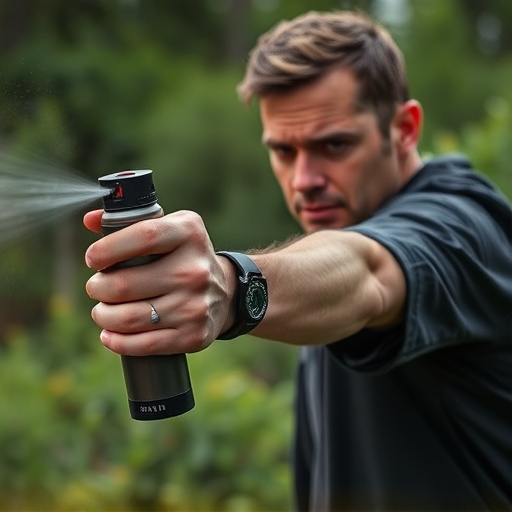Military-grade pepper spray formulas are specialized self-defense tools for law enforcement, leveraging capsaicin from chili peppers to induce temporary blindness and pain. Their effectiveness depends on concentration, delivery mechanism, and weather conditions, with high-quality formulations balancing potency and safety. These robust formulations, designed to military standards, offer reliable crowd control and non-lethal incapacitation, enhancing officer safety during volatile situations. Handheld devices cater to general use, while tactical systems are specialized for riot control or military operations. Responsible handling and comprehensive training ensure safe and effective deployment, minimizing harm to bystanders and the environment.
“In the realm of law enforcement, effective tools are paramount for maintaining public safety. One such instrument gaining prominence is military-grade pepper spray—a powerful yet precise force multiplier. This article delves into the intricate world of this equipment, exploring its core components and unique benefits. We dissect the active ingredients driving its effectiveness, highlighting the advantages of military-grade formulas over standard counterparts. Additionally, we navigate essential considerations in equipment selection and safety training, ensuring responsible use.”
- Understanding Pepper Spray: Active Ingredients and Effectiveness
- Military-Grade Formulas: Features and Benefits for Law Enforcement
- Equipment Considerations: Handheld Devices vs. Tactical Applications
- Safety and Training: Responsible Use and Deconfining the Risks
Understanding Pepper Spray: Active Ingredients and Effectiveness
Pepper spray, a powerful law enforcement tool, is a chemical agent designed to incapacitate and disrupt an individual’s ability to fight or flee. Understanding its active ingredients and effectiveness is crucial for both officers and those charged with maintaining public safety. Military-grade pepper spray formulas are known for their potency and reliability, utilizing capsaicin, the primary active ingredient found in chili peppers, to induce a burning sensation and temporary blindness.
The precision and effectiveness of these formulations vary based on factors like concentration, delivery mechanism, and weather conditions. High-quality military-grade sprays are engineered to provide a balanced blend of potency and safety, ensuring officers have a reliable tool for self-defense while minimizing collateral damage to bystanders.
Military-Grade Formulas: Features and Benefits for Law Enforcement
Law enforcement agencies often require specialized equipment to maintain public safety, and military-grade pepper spray formulas play a significant role in this regard. These formulations are designed with robustness and effectiveness in mind, ensuring officers have a powerful tool for crowd control and self-defense. The term ‘military-grade’ implies that the spray meets stringent standards set by the military, guaranteeing its reliability under extreme conditions. This robust nature translates to longer-lasting effects, making it more effective against aggressive or violent individuals.
The benefits of using these formulas are numerous. They offer a non-lethal option for law enforcement, providing a safe alternative to firearms in certain situations. The precise application and quick-acting ingredients allow officers to incapacitate suspects temporarily without causing permanent harm. This level of control is invaluable in high-risk scenarios, enabling officers to manage volatile situations and protect both themselves and the public effectively.
Equipment Considerations: Handheld Devices vs. Tactical Applications
When it comes to law enforcement pepper spray equipment, one key consideration is the distinction between handheld devices and tactical applications. Handheld sprays are designed for general-purpose use, offering a quick and effective solution in close-quarters situations. These devices typically feature compact designs, making them easy to carry and deploy on the fly. On the other hand, tactical pepper spray systems cater to more specialized needs, such as those encountered by riot control units or military personnel.
Tactical applications demand robust equipment capable of handling extreme conditions and prolonged use. Military-grade pepper spray formulas are often preferred for their superior strength and resistance to weather factors. These advanced systems may include features like adjustable nozzle settings, longer reach, and specialized canisters designed for quick deployment during high-stress scenarios. Understanding these differences is essential in selecting the right pepper spray equipment for specific law enforcement roles and missions.
Safety and Training: Responsible Use and Deconfining the Risks
Law enforcement officers are often at high risk of physical harm during their duties, making proper equipment and training critical for their safety. One such essential tool is military-grade pepper spray formulas, designed to incapacitate and deescalate dangerous situations. However, with great power comes great responsibility; thus, comprehensive training on its responsible use is paramount.
Training should cover not only the physical application of the spray but also understanding when and where its use is appropriate. Officers must be equipped to manage risks associated with pepper spray, including its potential impact on bystanders and the environment. Deconfining these risks involves learning de-escalation techniques, proper targeting, and awareness of different pepper spray formulations. Effective training ensures that officers can deploy this powerful tool safely and ethically while mitigating the risks involved.
Law enforcement agencies now have access to advanced military-grade pepper spray formulas, offering enhanced effectiveness for tactical situations. By understanding the active ingredients and equipment considerations, such as handheld devices versus specialized applications, officers can ensure safe and responsible use. Proper training is paramount to mitigate risks, enabling law enforcement to leverage these powerful tools while maintaining public safety during critical incidents.
